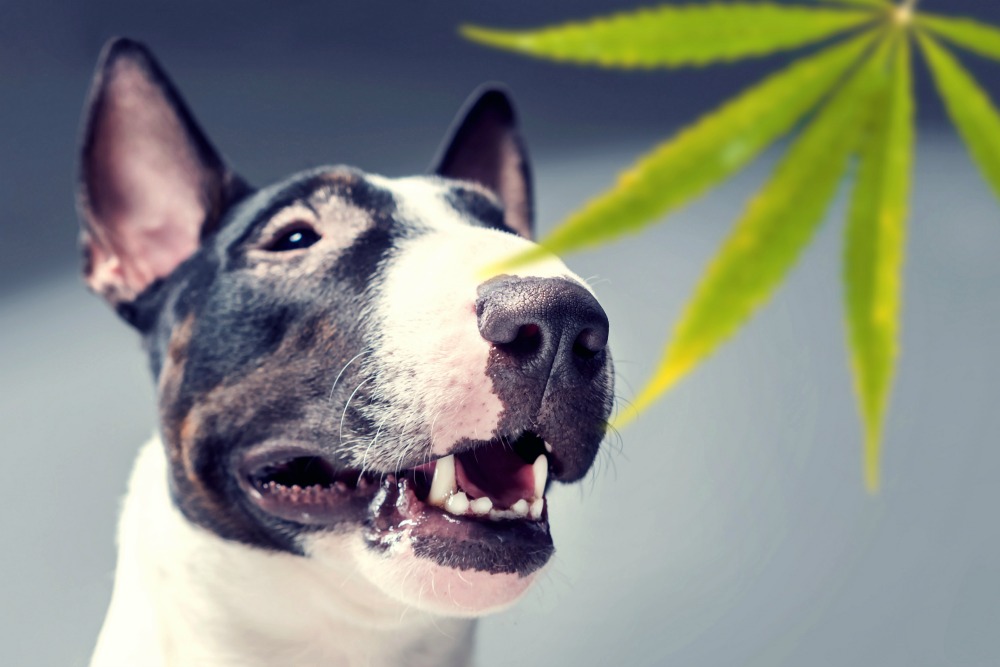With the legalization of recreational cannabis use coming into effect on 17 October 2018 and the growing acceptance of cannabis and cannabis-derived products in human therapeutics, we as veterinarians are expecting both increased interest in using cannabis and cannabinoid products in pets as well as increased toxicity cases, especially in dogs.
The plant Cannabis spp., found worldwide, has many different subspecies or strains, each with varying properties of phytocannabinoids, terpenes, flavonoids and other compounds. Nonpsychogenic strains are lower in THC (Tetrahydrocannabinol), and are used in the food and fibre industry. Psychogenic strains, with varying THC levels, are used in medical therapy. Of the hundreds of compounds found in Cannabis spp. so far, over 100 are phytocannabinoids. The best known are THC, CBD (Cannabinoid), CBN, and CBG. These are being used to produce cannabis-derived products for drug approval and, along with other phytocannabinoids, are being studied for their potential use in human medicine, for a multitude of unrelated conditions.
There are no Health Canada–approved CBD products for animals.
There are currently over 100 licensed natural products in Canada that contain Cannabis sp. or a derivative (mostly hemp seed). These include Veterinary Health Products containing hemp seed or hemp seed oil. Their use is promoted by companies, cannabis enthusiasts, and some physicians and veterinarians. Food animal producers are also interested in the use of hemp seeds and other cannabis products. While our knowledge of cannabis is rapidly advancing, we have significant gaps in our veterinary knowledge. We do not know, in any of our patient species, mechanisms of actions, pharmacokinetics, or pharmacodynamics.
There are a handful of studies in progress, and with increased interest, we hope to see many more that apply to our patients. Using whole or partial plants, currently considered the better practice among some practitioners, provides no reliable efficacy or dosing because of variabilities in strains, growing conditions, and suppliers, with varied and unpredictable side effects. For any cannabis product, a physician, pharmacist, or veterinarian will want a Certificate of Analysis of THC, CBD, and other compounds, and be assured of consistency in the formulation.
Consideration of the legal aspects of cannabis prescribing by veterinarians is of equal importance to the medicine. Currently, all parts of the Cannabis spp. plant and substances derived from it are controlled as a Schedule II substance, unless exempt under the Industrial Hemp Regulations (IHR), Access to Cannabis for Medical Purposes Regulations (ACMPR), or through a research exemption (Controlled Drug and Substances Act, CDSA). Veterinarians need to understand that the ACMPR applies to “persons,” not “patients,” and that veterinarians and veterinary patients are not included in these regulations. The IHR defines “hemp” as a Cannabis spp. a cultivar that contains less than 0.3% THC in leaves and flowers and allows licensed “hemp” producers to grow “hemp,” but only the stalks and seeds may be used in products that must be under 10ppm THC. Through the Veterinary Drugs Directorate, Health Canada evaluates and monitors the safety, quality, and effectiveness; sets standards; and promotes the prudent use of veterinary drugs administered to food-producing and companion animals.
Currently, veterinarians without a research exemption have no legal pathway to prescribe cannabis or cannabis-derived products.
The Federal Bill C-45, the Cannabis Act, will remove cannabis from the CDSA Schedule 11 and legalize access to recreational cannabis in Canada when it comes into force on October 17, 2018. The CVMA has lobbied for the inclusion of veterinarians and veterinary patients into the Cannabis Act, labelling for the safety and prevention of toxicity in animals, and for inclusion of CBD products to the veterinary drug list.
There are no Veterinary Health Drugs with cannabis or cannabis-derived ingredients expected in the near future.
Summarized from an article by NICOLETTE JOOSTING, DVM in West Coast Veterinarian Magazine, Sept 2018
Written By: Dr. Alex Hare, DVM




